 We’ve all been there – you wait anxiously for the rollout the new models each year, ogling the bright shiny ads and binge-watching The Watercraft Journal Galleries announcing the new manufacturer lineups, you plot and plan and daydream about the coming season on the top-of-the-line, brand-spanking new ski with all the fancy doodads… and then Johnny needs braces, the water heater needs replacing, the spouse wants to redo the kitchen that still has harvest-gold appliances, and you’re standing here headed into April with empty pockets and pipe dreams.
We’ve all been there – you wait anxiously for the rollout the new models each year, ogling the bright shiny ads and binge-watching The Watercraft Journal Galleries announcing the new manufacturer lineups, you plot and plan and daydream about the coming season on the top-of-the-line, brand-spanking new ski with all the fancy doodads… and then Johnny needs braces, the water heater needs replacing, the spouse wants to redo the kitchen that still has harvest-gold appliances, and you’re standing here headed into April with empty pockets and pipe dreams.
So, ok, maybe a brand new model is not in the cards for this year…but never fear, there Are options. Dozens and dozens and dozens of options – you just have to look for them – well, look for them, and be willing to be realistic about your limitations and your needs. But realistic doesn’t have to end up being the PWC version of the real-estate “fixer-upper” – in fact, you’re better off doing your research, knowing your facts before you jump into the used PWC market, and having some guiding principles at hand before you dive into the search for your new-to-you PWC.
 Diving back several years to one of our most popular articles at the time, and pooling wisdom from dozens of PWCers with decades of experience, we are taking a fresh look at the advice from our Ultimate Used Watercraft Buyers Guide. While PWCs have changed over the years, and technology has advanced, the baseline process for selecting just the right used PWC for your riding style, skill level, interests and time commitment remains essentially unchanged, as does the checklist of things to look for, things to avoid, and questions to ask.
Diving back several years to one of our most popular articles at the time, and pooling wisdom from dozens of PWCers with decades of experience, we are taking a fresh look at the advice from our Ultimate Used Watercraft Buyers Guide. While PWCs have changed over the years, and technology has advanced, the baseline process for selecting just the right used PWC for your riding style, skill level, interests and time commitment remains essentially unchanged, as does the checklist of things to look for, things to avoid, and questions to ask.
The main concerns in buying used are what to look for in order to not end up buying someone else problems, and how to avoid buying a lemon.
While searching online sources like dealer inventory, Craigslist PWC trader and Facebook sales/ swap groups, there are many skis to choose from, but which one is the right one?
Buying and owning a jet ski comes down to 3 basic costs. You have initial cost, maintenance cost and service cost. That cheap ski may have a low initial cost, but may need some work or maintenance to bring it to proper running condition. That may make it more expensive in the long run than buying a running ski. We also know that condition is everything and previous maintenance or lack of maintenance could spell disaster in the long run, but what to look for to avoid buying a nightmare?
Finally, a buyer must be realistic. You usually get what you pay for and if the deal is way too good to be true, chances are there’s a reason why and that may not be good for you. The group chimed in and this basic guide should help you along in your buying process:
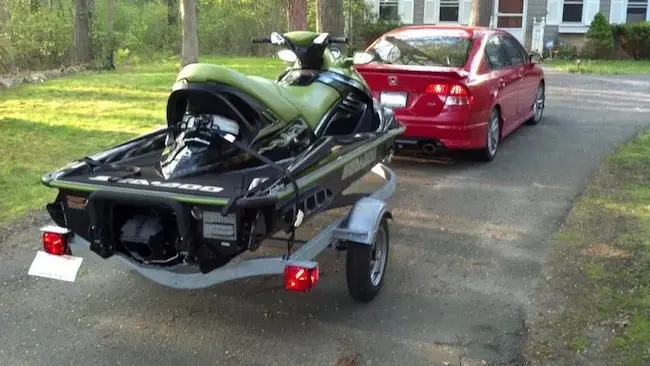 Presale
Presale
Do your homework! Look online and find out what everyone else is riding or staying away from. Check ride groups, local riders, forums like Greenhulk.net, Google searches and even YouTube to get as much info under your belt as possible. Keep an open mind and check out brands and models. Keep an eye on the year ski as manufacturers may have changed engine configuration, features or hull design that may affect the value and performance. Have a good grip on the KBB and NADA values as to not overpay and to have a good idea on what it’s actually worth. Don’t be afraid to ask questions now as it may save you from problems down the line.
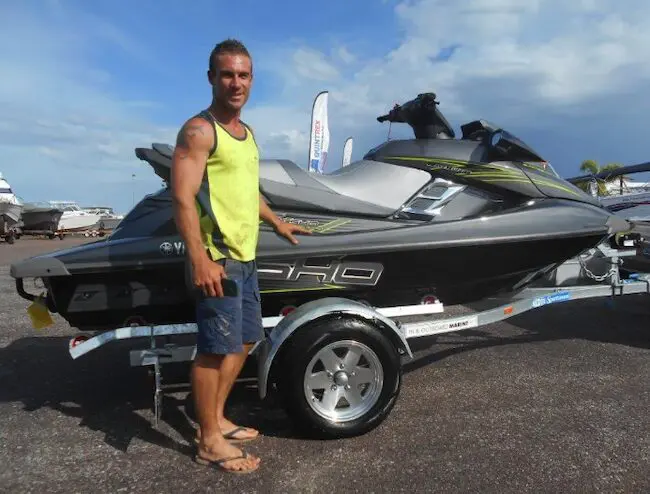 The Seller
The Seller
Private Seller
After you’ve found a ski, the seller can be just as important as the ski itself. How it was maintained, what’s the reason for the sale, maintenance records and potential issues can help or hurt the ski sale. Find a seller that is open, honest, fair, and who’s willing to work with you in the sale and the transfer of ownership. Make sure to get a proper working contact number. They should have the proper paperwork like clear title, registration, trailer registration, manuals, warranty info, service or repair records, and bill of sale on hand to complete the sale. Set a location that is public and convenient for the sale. A public boat ramp is great as lots of traffic and a place to provide the water test portion of the sale.
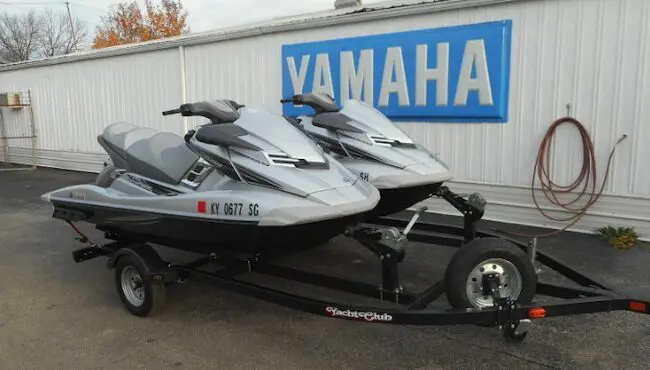 Dealer Pre-owned
Dealer Pre-owned
This is a great option if you’re able to get one that has warranty or has been dealer inspected or certified. There will be tax, title and registration fees upfront, but it’s a one stop shop. Some manufacturers like Yamaha have certified pre-owned skis and you may even be able to buy a 2-year used warranty if purchased from an authorized dealer. You should still know what you’re buying and especially the KBB or NADA trade in, average and dealer retail values to know what deal you may be getting.
Inspection
Check the Hull
Is it as pictured and in overall good condition for the year? Are the hull or plastic moldings badly sunfaded? Is there anything hiding damage marked under excessive dirt, WD-40 spray or large decals? Is it missing parts? Any deep scratches or gouges to the fiberglass on the hull and especially on the belly? Are there signs of recent repair? Does the display gauge work and does it show any codes, maintenance alerts or weird beeps? Does the jet pump area look pitted or corroded? Do you see heavy rust or corrosion that can give an idea on how it was maintained? Is there anything in the pump intake, chips on the impeller or excess wear/ clearance on the wear ring? Are the seats in good condition as well as the foot mats?
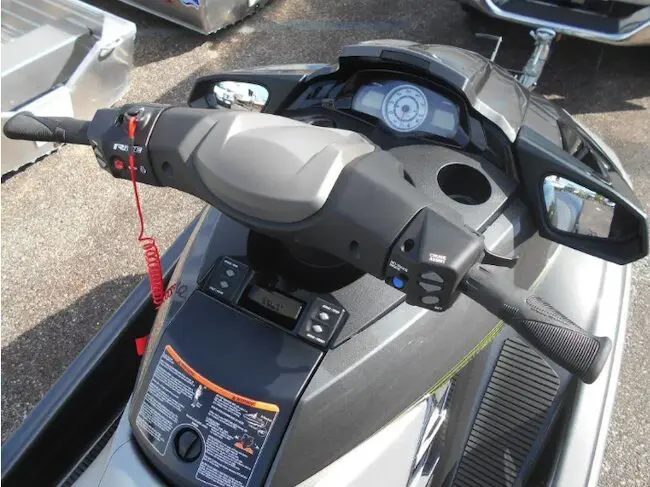
Check The Functions
Is the steering, throttle, choke or reverse easy to operate? Do features like trim, RiDE or IBR function properly? Does the hood strut work? If it has a bilge pump, does it work? Does the key fob properly operate the modes or are the proper function keys there for the performance modes? Does the display reflect the correct hours?
Check the Engine Bay
Are there signs of recent or undisclosed repair like greasy hand or fingerprints or is everything in overall good order? Check the engine bolts for missing or damaged paint that may be a sign of previous disassembly. Does the wiring seem in order? Are there signs of corrosion or rust on engine parts, clamps or terminals? Check the engine oil to see if it’s at the proper level and also note the color. Do you see any waste oil or water inside the hull? Do the function cables have frays or rust splits? Do you see sloppy aftermarket sealant? Do you smell gas? Do you see any loose parts? Are the hoses and cables all attached?
Water Test
It’s very important in a “AS IS, NO REFUNDS” sale. A water test can show more than just a start up or an idle/ revving on a water hose. It can reveal engine issues, cavitation issues, overheating issues, water leaks and other running problems. You should check the hull for water prior to water testing and make sure the drain plugs are in.
Does it seem to start and idle properly? Make sure cooling water is exiting the proper outlets. Does it accelerate properly or hesitate? Does it cavitate? Meaning does the engine rev up to the appropriate rpm, but the ski doesn’t have the take off or get on plane properly. Does it feel sluggish? Does it sound weird? Does it stall?
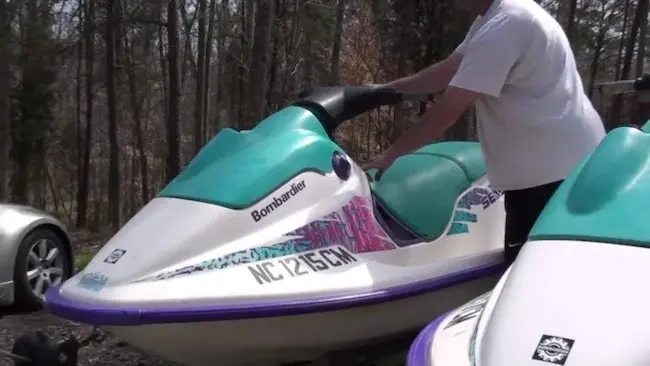 Does it hit the right top speed and the right top rpm? Download an app that gives GPS readings to be sure that you are hitting top speed. A proper top speed can mean the engine and jet pump are operating properly. Make sure that you test ride for an adequate amount of time so that the engine is at proper operating temperature and performing as expected. After the test ride, check the hull again for signs of excessive water. Water now coming out the drain plugs is a bad sign!
Does it hit the right top speed and the right top rpm? Download an app that gives GPS readings to be sure that you are hitting top speed. A proper top speed can mean the engine and jet pump are operating properly. Make sure that you test ride for an adequate amount of time so that the engine is at proper operating temperature and performing as expected. After the test ride, check the hull again for signs of excessive water. Water now coming out the drain plugs is a bad sign!
Paperwork
Double check the title or registration card to the HIN plate. A clear title, especially in a title state like Florida, is a deal breaker. The HIN plate should be on the hull of the ski and should not look tampered with. There should be no name in the buyer fields and the seller information should be correct and properly filled out.
Check for liens and make sure there are no correction attempts that could void the title. Make sure the Bill Of Sale reflects the information on the title as well as selling price, signatures and sale date. You usually have 30 days to transfer the ski and trailer. If a trailer is involved, make sure the trailer registration also matches the trailer registration plate, the buyer field is clear and the seller info is properly filled out.
Have your +1 count the cash and payment is made as the Bill Of Sale and the paperwork is finalized as well as the ski transferred in whatever order comfortable to everyone. Make sure to get whatever maintenance records, repair records, general ski info, warranty if applicable, registration cards possible at the time of sale as failure to do so may lead to potential delays or future expenses.
It’s a terrible idea to pay a seller and not get a proper title or paperwork. It’s best to wait or walk before losing your money on a ski or trailer that you can’t legally register. Things can happen and sellers disappear while waiting on a title, bill of sale or trailer registration. You don’t want to be stuck with a ski or trailer that you can’t transfer in your name and enjoy. A bill of sale only will not work especially in Florida. A properly filled out title is a must have.
Post Sale
Have the ski and trailer transferred/registered in your name asap. You have 30 days, but sooner the better. Make sure the ski is in proper working order prior to riding with any maintenance or repair done. A small issue can become a major problem if left unattended.
Make sure you are water legal with the proper registration numbers and decals, support gear and accessories. Tickets on the water are expensive! Find a great group of guys n gals and ride! A major reason for skis being sold is from a lack of use. Find like minded people and ride! Don’t make it a major event to get out and enjoy the water. The more you get out, the easier it becomes and the more areas you ride, the better the experiences!
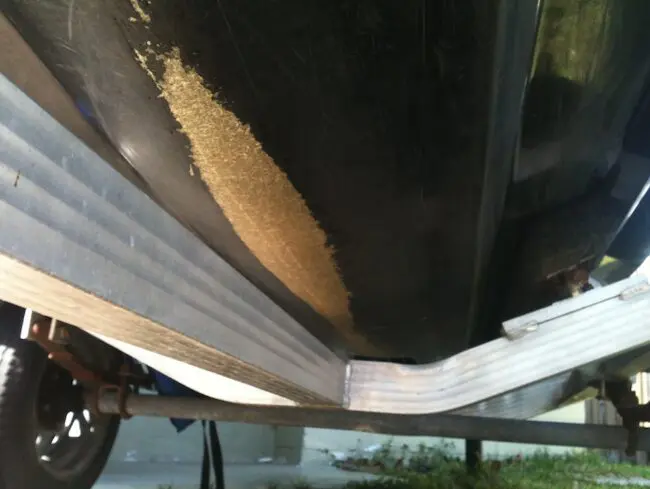 Project/Non-Running Skis
Project/Non-Running Skis
Last but definitely not least is buying that non running gem. That cheap price is an eye catcher and maybe it could be a simple fix! More likely than not, it isn’t and may end up costing more to repair it than to buy one running. The key is to buy cheap expecting the worst, but hoping for the best. Find out was the worst case scenario repair cost is and make an offer from there.
Remember you are fixing two issues, what caused the failure and the results of that failure to get it back in running condition. Chances are the dead battery, bad starter or whatever other too simple to be true explanation may be a sellers ploy to get the most for a busted ski. If it was that simple, they could have probably fixed it and kept it or sold it for more. If you can’t prove it in an inspection, don’t believe it!
You’re already buying someone else’s problem to some degree. Do your homework on what repair costs and factor in labor if you aren’t comfortable doing the repairs yourself. Get the service manual that properly outlines the repair process for that ski and don’t skimp on a repair. Do what is called for as to not be doing it again in the future.
When possible, check the engine compression if it turns over. If it doesn’t, see if it’s possible to turn the driveshaft. Check the sparkplugs for signs of piston contact, excessive rust or signs of wear. Look in the sparkplug hole for signs of seizure. Check the whole ski over for missing parts and to make sure it’s as whole as possible. Skis that have been to a shop or previously torn down but not reassembled may be missing bolts and other critical parts.
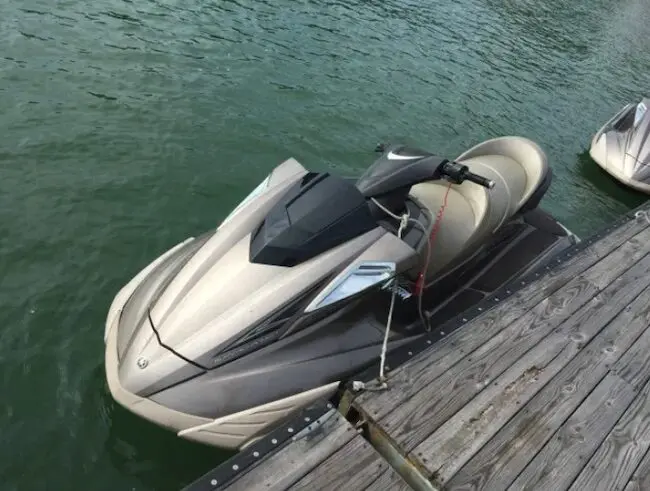 Everything adds up in a project. A bad display gauge, stiff steering or reverse cables, ripped seats or mats all add up and may push that repair cost over the value of the ski. Don’t pay more to fix a ski than it’s worth! Check the pump for obstructions like rope, rocks or corrosion that could prevent the engine from turning over. Check the engine bay for metal chunks, spent oil or greasy smears. Also keep an eye for loosely replaced parts or mismatched bolts which is a sign of an engine thrown back together hastily for resale.
Everything adds up in a project. A bad display gauge, stiff steering or reverse cables, ripped seats or mats all add up and may push that repair cost over the value of the ski. Don’t pay more to fix a ski than it’s worth! Check the pump for obstructions like rope, rocks or corrosion that could prevent the engine from turning over. Check the engine bay for metal chunks, spent oil or greasy smears. Also keep an eye for loosely replaced parts or mismatched bolts which is a sign of an engine thrown back together hastily for resale.
And don’t forget these tips from The Worldwide Stolen PWC Database. The last thing you want when buying a used ski is to purchase a stolen one. We have a list of precautions and procedures to check for when buying to make sure that does not happen:
Check the HIN Every watercraft comes from the factory with a HIN (Hull Identification Number). This number is unique to each ski. When purchasing a used watercraft, it is a good idea to look for evidence of tampering, as this may mean the PWC you’re looking into has been stolen. Look for signs of scratches as well as any oddities in the number itself. For example, the year of the ski is normally the last two numbers in the HIN. If you know the ski you’re looking at is a 2010, but the last two numbers of the HIN are 12, then you should probably steer clear of this PWC and the seller.
Get to Know the Seller It would also be a good idea to get to know the seller as much as possible. A visit to his/her house to look at the ski is generally a good way. While it may be tempting to simply ask to meet on the water so you can go for a test ride, it would be best to go visit the seller’s address, then ask if you could go to the water to test it.
Use an Independent HIN Checking Service There are several sites that hold marine watercraft history and reports that contain information about many different types of marine vessels. From our experience, though, this information varies substantially from site to site. It would be a good idea to make sure you are using a reputable source for your info, such as the Worldwide Stolen PWC Database. They work with many different agencies to gather up the most accurate information they can provide you with.
Commit with a Written Agreement If all the prior check out and you’re ready to make a purchase, then try to get a simple contract for the both of you to sign, just to show the agreement of sale. It does not need to be a 20 page document full of legal terms, just a simple contract stating the facts of the sale (where you both live, what is being sold, the seller is the rightful owner, etc.).
With this signed by both of you, you will have a formal agreement between you and the seller as well as an extra layer of protection for yourself. Don’t forget, verify the seller’s identity by means of an ID, driver’s license, passport, etc.
Use Common Sense While the Worldwide Stolen PWC Database is able to quickly and accurately inform you if the PWC you’re looking to purchase is registered on their database, it should only be used as another tool in your buying arsenal. Remember, unfortunately not everyone reports it to them right away when their PWC has been stolen, so we can’t pass on the warning. If the deal you’re being offered is too good to be true, it probably is.
Check if the service/repair work looks legitimate. If possible, contact the dealer who serviced it to confirm the work.
Keep in mind, sellers will expect you to be a bit skeptical when making a high value purchase. A legitimate seller will be much more comfortable answering any questions you have than somebody who has something to hide.









